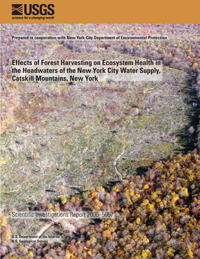Scientific Investigations Report 2008–5057

Prepared in cooperation with the
New York City Department of Environmental Protection
The effects of forest clearcutting and selective harvesting on forest soils, soil and stream water chemistry, forest regrowth, and aquatic communities were studied in four small headwater catchments. This research was conducted to identify the sensitivity of forested ecosystems to forest disturbance in the northeastern United States. The study area was in the headwaters of the Neversink Reservoir watershed, part of the New York City water supply system, in the Catskill Mountains of southeastern New York. Two sub-catchments of the Shelter Creek watershed were selectively harvested, one in its northern half and one more heavily in its southern half in 1995–96, the Dry Creek watershed was clearcut in the winter of 1996–97, and the Clear Creek watershed was left undisturbed and monitored as a control site. Monitoring was conducted from 4 years before the harvests until 4 years after the harvests. Clearcutting caused a large release of nitrate (NO3-) from watershed soils and a concurrent release of inorganic monomeric aluminum (Alim), which is toxic to some aquatic biota. The increased soil NO3- concentrations measured after the harvest could be completely accounted for by the decrease in nitrogen (N) uptake by watershed trees, rather than an increase in N mineralization and nitrification. The large increase in stream water NO3- and Alim concentrations caused 100-percent mortality of caged brook trout (Salvelinus fontinalis) during the first year after the clearcut and adversely affected macroinvertebrate communities for 2 years after the harvest. Nutrient uptake and biomass accumulation increased in uncut mature trees after the two selective harvests. There was no increase in stream-water NO3- or Alim concentrations, and so there were no adverse affects on macroinvertebrate or trout communities. The amount of tree biomass that can be removed without causing a sharp increase in stream-water NO3- and Alim stream-water concentrations is unknown, but probably depends on the history of forest-disturbance and acid deposition and the level of soil acidification. Results of this study indicate that macroinvertebrate and brook trout communities were sensitive to clearcutting and that deer browsing may affect water quality by suppressing forest regeneration and nutrient uptake. Further studies of selective harvests could identify the harvesting threshold below which changes in water quality and soil chemistry are minimized, and nutrient retention is maximized, thus reducing the damage that logging can inflict on stream and aquatic communities.
McHale, M.R., Murdoch, P.S., Burns, D.A., and Baldigo, B.P., 2008, Effects of forest harvesting on ecosystem health in the headwaters of the New York City water supply, Catskill Mountains, New York: U.S. Geological Survey Scientific Investigations Report 2008–5057, 22 p., also available online at http://pubs.usgs.gov/sir/2008/5057/
For further information, contact:
Director
U.S. Geological Survey
New York Water Science Center
425 Jordan Road
Troy, NY 12180
Email: dc_ny@usgs.gov
Phone: (518)285-5600
Visit our web site: http://ny.water.usgs.gov
This report is available PDF Format (2.6 MB)
If you have Adobe® Acrobat® or Adobe ® Acrobat® Reader® installed on your computer, you may view and print the PDF version of this report. Acrobat Reader, is a free download from Adobe Systems, Inc. Users with disabilities can view information concerning accessibility at access.Adobe.com.